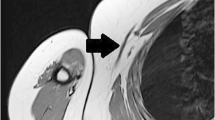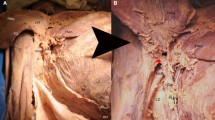Abstract
Introduction
Typically, the axillary arch is defined as a fleshy slip running from latissimus dorsi to the anterior aspect of the humerus. Phylogeny seems to give the most relevant and plausible explanation of this anatomical variant as a remnant of the panniculus carnosus. However, authors are not unanimous about its origin. We report herein the incidence of axillary arch in a series of 40 human female dissections and present an embryologic and a comparative study in three domestic mammals.
Materials and methods
Forty formalin-preserved Caucasian human female cadavers, one rat (Rattus norvegicus), one rabbit (Oryctolagus cuniculus) and one pig (Sus scrofa domesticus) cadavers were dissected bilaterally. A comparative, analytical and a descriptive studies of serial human embryological sections were carried out.
Results
We found an incidence of axillary arch of 2.5% (n = 1 subject of 40) in Humans. We found a panniculus carnosus inserted on the anterior aspect of the humerus only in the rat and the rabbit but not in the pig. The development of the latissimus dorsi takes place between Carnegie stage 16–23, but the embryological study failed to explain the genesis of the axillary arch variation. However, comparative anatomy argues in favour of a panniculus carnosus origin of the axillary arch.
Conclusions
With an incidence of 2.5% of cases, the axillary arch is a relatively frequent variant that should be known by clinician and especially surgeons. Moreover, while embryology seems to fail to explain the genesis of this variation, comparative study gives additional arguments which suggest a possible origin from the panniculus carnosus.










Similar content being viewed by others
References
Arey LB (1935) Developmental anatomy. A text-book and laboratory manual of embryology, 3rd edn. W.B Saunders Company, Philadelphia
Bakkum BB, Miller N (2016) Back mucles. Bergman’s comprehensive encyclopedia of human anatomic variation, 1st edn. Wiley, Hoboken
Baulac M, Meininger V (1981) Organization of pectoral muscle motor neurons in the rat. Contribution to the study of the axillary arch (Achselbogen). Acta Anat (Basel) 109:209–217
Bergman RA, Afifi AK, Miyauchi R (1996) Illustrated encyclopedia of human anatomic variation. https://www.anatomyatlases.org/AnatomicVariants/AnatomyHP.shtml#TOC
Besana-Ciani I, Greenall MJ (2005) Langer’s axillary arch: anatomy, embryological features and surgical implications. Surg J R Coll Surg Edinb Irel 3:325–327. https://doi.org/10.1016/s1479-666x(05)80111-8
Bonastre V, Rodriguez-Niedenfuhr M, Choi D, Sanudo JR (2002) Coexistence of a pectoralis quartus muscle and an unusual axillary arch: case report and review. Clin Anat 15:366–370. https://doi.org/10.1002/ca.10053
Chene G, Le Bouedec G, Dauplat J (2007) Arch and sentinel: surgical technique of sentinel node biopsy with the axillopectoral muscle. Gynecol Obstet Fertil 35:25–29. https://doi.org/10.1016/j.gyobfe.2006.10.031
Cork R, Gasser R (2002) The virtual human embryo. https://virtualhumanembryo.lsuhsc.edu. Accessed 28 May 2020
Daniels IR, della Rovere GQ, (2000) The axillary arch of Langer–the most common muscular variation in the axilla. Breast Cancer Res Treat 59:77–80. https://doi.org/10.1023/a:1006367904056
Fodor PB (1993) From the panniculus carnosum (PC) to the superficial fascia system (SFS). Aesthet Plast Surg 17:179–181. https://doi.org/10.1007/bf00636259
Fontaine C (2001a) Some help for literature study in anatomical variation reports. Surg Radiol Anat 23:293–294
Fontaine C (2001b) Some thoughts about anatomic variations. Surg Radiol Anat 23:1–2
Gasser RF, Cork RJ, Stillwell BJ, McWilliams DT (2014) Rebirth of human embryology. Dev Dyn Off Publ Am Assoc Anat 243:621–628. https://doi.org/10.1002/dvdy.24110
Hamilton WJ, Boyd JD, Mossman UW (1978) Human embryology, 4th edn. Macmillan Press LTD, London
Haninec P, Tomas R, Kaiser R, Cihak R (2009) Development and clinical significance of the musculus dorsoepitrochlearis in men. Clin Anat 22:481–488. https://doi.org/10.1002/ca.20799
Jelev L, Georgiev GP, Surchev L (2007) Axillary arch in human: common morphology and variety. Definition of “clinical” axillary arch and its classification. Anna Anat Anatomischer Anz Off Organ Anatomische Ges 189:473–481. https://doi.org/10.1016/j.aanat.2006.11.011
Jung SJ, Lee H, Choi IJ, Lee JH (2016) Muscular axillary arch accompanying variation of the musculocutaneous nerve: axillary arch. Anat Cell Biol 49:160–162. https://doi.org/10.5115/acb.2016.49.2.160
Kalaycioglu A, Gumusalan Y, Ozan H (1998) Anomalous insertional slip of latissimus dorsi muscle: arcus axillaris. Surg Radiol Anat 20:73–75. https://doi.org/10.1007/bf01628121
Ko K, Han BK, Shin JH, Choe YH, Chung HW, Lee EH, Choi SJ (2006) The axillopectoral muscle seen on mammography. Clin Radiol 61:625–629. https://doi.org/10.1016/j.crad.2006.03.015
Langer C (1846a) Zur Anatomie des Musculus latissimus dorsi. Österr Med Wochenschrift 15:454–458
Langer C (1846b) Zur Anatomie des Musculus latissimus dorsi (Schluss). Österr Med Wochenschrift 15:486–492
Langman J, Sadler TW (2007) Embryologie Médicale. 8e édition française edn. Pradel, Rueil-Malmaison
Le Double AF (1893) Les anomalies du muscle grand dorsal. Bulletins de la Société d’anthropologie de Paris Tome 4:626–653. https://doi.org/10.3406/bmsap.1893.5476
Lhuaire M (2016) Étude Anatomique des pédicules épigastriques inférieurs, subscapulaire et thoracique interne: Applications chirurgicales. Médecine Université de Reims Champagne-Ardenne, Reims
Lhuaire M, Hivelin M, Derder M, Hunsinger V, Delmas V, Abrahams P, Sommacale D, Kianmanesh R, Fontaine C, Lantieri L (2019) Anatomical variations of the subscapular pedicle and its terminal branches: an anatomical study and a reappraisal in the light of current surgical approaches. Surg Radiol Anat 41:385–392. https://doi.org/10.1007/s00276-018-2161-7
Lhuaire M, Hivelin M, Drame M, Abrahams P, Kianmanesh R, Fontaine C, Lantieri L (2017) Determining the best recipient vessel site for autologous microsurgical breast reconstruction with DIEP flaps: an anatomical study. J Plast Reconstr Aesthet Surg 70:781–791. https://doi.org/10.1016/j.bjps.2017.01.008
Lhuaire M, Hivelin M, Hunsinger V, Derder M et al. (2020) Descriptive anatomy of the inferior epigastric, subscapular and internal thoracic vascular pedicles in three domestic mammals: A comparative study. Morphologie. https://doi.org/10.1016/j.morpho.2020.10.002
Lhuaire M, Martinez A, Kaplan H, Nuzillard JM, Renard Y, Tonnelet R, Braun M, Avisse C, Labrousse M (2014) Human developmental anatomy: microscopic magnetic resonance imaging (muMRI) of four human embryos (from Carnegie Stage 10 to 20). Anna Anat Anatomischer Anz Off Org Anatomische Ges 196:402–409. https://doi.org/10.1016/j.aanat.2014.07.004
Lhuaire M, Tonnelet R, Renard Y, Piardi T, Sommacale D, Duparc F, Braun M, Labrousse M (2015) Developmental anatomy of the liver from computerized three-dimensional reconstructions of four human embryos (from Carnegie stage 14 to 23). Anna Anat Anatomischer Anz Off Organ Anatomische Ges 200:105–113. https://doi.org/10.1016/j.aanat.2015.02.012
Lockwood TE (1991) Superficial fascial system (SFS) of the trunk and extremities: a new concept. Plast Reconstr Surg 87:1009–1018. https://doi.org/10.1097/00006534-199106000-00001
Loukas M, Noordeh N, Tubbs RS, Jordan R (2009) Variation of the axillary arch muscle with multiple insertions. Singap Med J 50:e88-90
Merida-Velasco JR, Rodriguez Vazquez JF, Merida Velasco JA, Sobrado Perez J, Jimenez Collado J (2003) Axillary arch: potential cause of neurovascular compression syndrome. Clin Anat 16:514–519. https://doi.org/10.1002/ca.10143
Miguel M, Llusa M, Ortiz JC, Porta N, Lorente M, Gotzens V (2001) The axillopectoral muscle (of Langer): report of three cases. Surg Radiol Anat 23:341–343. https://doi.org/10.1007/s00276-001-0341-2
Moriggl B, Fontaine C (2004) Strengthening editors’ policy concerning publication of anatomic variations. Surg Radiol Anat 26:1–2. https://doi.org/10.1007/s00276-003-0211-1
Naldaiz-Gastesi N, Bahri OA, Lopez de Munain A, McCullagh KJA, Izeta A (2018) The panniculus carnosus muscle: an evolutionary enigma at the intersection of distinct research fields. J Anat. https://doi.org/10.1111/joa.12840
Omar N, Abidin FZ, Das S, Abd Ghafar N, Haji Suhaimi F, Abd Latiff A, Othman F (2010) The axillary arch - morphological and histological study with clinical importance. Morphologie 94:36–39. https://doi.org/10.1016/j.morpho.2010.03.001
Pitzorno H (1911) Contributo alla morfologia dell’arco ascellare musculare di Langer. Arch Ital Anat Embryol 10:129–144
Rose EH, Vistnes LM, Ksander GA (1977) The panniculus carnosus in the domestic pig. Plast Reconstr Surg 59:94–97. https://doi.org/10.1097/00006534-197701000-00017
Sachatello CR (1977) The axillopectoral muscle (Langer’s axillary arch): a cause of axillary vein obstruction. Surgery 81:610–612
Sakanaka K, Yamamoto M, Ishibashi T, Yanagisawa N, Rodriguez-Vazquez JF, Murakami G, Abe SI (2017) Teres major and latissimus dorsi muscles in human embryos: a reconsideration of the so-called brother muscles. Okajimas Folia Anat Jpn 94:81–85. https://doi.org/10.2535/ofaj.94.81
Serpell JW, Baum M (1991) Significance of ‘Langer’s axillary arch’ in axillary dissection. Aust NZ J Surg 61:310–312
Sicher H (1911) Zur Morphologie des Achselbogens beim Menschen. Gebenbaur’s Morphol Jahrb 43:339–344
Snoeck T, Balestra C, Calberson F, Pouders C, Provyn S (2012) The innervation of the axillary arch determined by surface stimulodetection electromyography. J Anat 221:275–278. https://doi.org/10.1111/j.1469-7580.2012.01539.x
Stell PM (1977) The pig as an experimental model for skin flap behaviour: a reappraisal of previous studies. Br J Plast Surg 30:1–8. https://doi.org/10.1016/s0007-1226(77)90026-1
Takafuji T, Igarashi J, Kanbayashi T, Yokoyama T, Moriya A, Azuma S, Sato Y (1991) The muscular arch of the axilla and its nerve supply in Japanese adults. Kaibogaku zasshi J Anat 66:511–523
Taterra D, Henry BM, Zarzecki MP, Sanna B, Pekala PA, Cirocchi R, Walocha JA, Tubbs RS, Tomaszewski KA (2019) Prevalence and anatomy of the axillary arch and its implications in surgical practice: a meta-analysis. Surg J R Coll Surg Edinb Irel 17:43–51. https://doi.org/10.1016/j.surge.2018.04.003
Testut L (1884) Les anomalies musculaires chez l’Homme expliquées par l’anatomie comparée et leur importance en anthropologie. Masson, Paris
Testut L (1921) Traité d’anatomie topographique avec applications médico-chirurgicales, vol Tome II. Abdomen, Bassin, Membres. 3ème ed. edn. Octave Doin et fils, Paris
Turgut HB, Peker T, Gülekon N, Anil A, Karaköse M (2005) Axillopectoral muscle (Langer’s muscle). Clin Anat 18:220–223. https://doi.org/10.1002/ca.20077
Wilke J, Krause F, Niederer D, Engeroff T, Nurnberger F, Vogt L, Banzer W (2015) Appraising the methodological quality of cadaveric studies: validation of the QUACS scale. J Anat 226:440–446. https://doi.org/10.1111/joa.12292
Acknowledgements
We are grateful to the donors of the Institute of Anatomy and Organogenesis of Lille and their families without whom anatomical studies for medical research advancements and education of future healthcare providers would not be possible. We thank Maurice De Meulaere, Fabien Descamps and Franck Stevendart from the Institute of Anatomy and Organogenesis of Lille for their assistance throughout the dissections. We thank Martin Fourdrinier and Arnold Dives from the department of animal experimentations of Lille University for their assistance throughout the dissections. We also thank Dr R. John Cork for permission to use images from the Virtual Human Embryo project (available at https://virtualhumanembryo.lsuhsc.edu).
Author information
Authors and Affiliations
Contributions
All persons listed as authors have contributed substantially to the design, performance, analysis and reporting of this work. ML, KW, IG, VH, MD, VB: collected data, analyzed data, wrote paper. VD, PH, DS, RK: analyzed data, wrote paper. ML, LL, CF: Designed study, analyzed data, wrote paper.
Corresponding author
Ethics declarations
Conflict of interest
The authors declare that they have no conflicts of interest.
Additional information
Publisher's Note
Springer Nature remains neutral with regard to jurisdictional claims in published maps and institutional affiliations.
Rights and permissions
About this article
Cite this article
Lhuaire, M., Wehbe, K., Garrido, I. et al. Anatomy of the axillary arch: from its incidence in human to an embryologic and a phylogenetic explanation of its origins. Surg Radiol Anat 43, 619–630 (2021). https://doi.org/10.1007/s00276-020-02605-5
Received:
Accepted:
Published:
Issue Date:
DOI: https://doi.org/10.1007/s00276-020-02605-5




